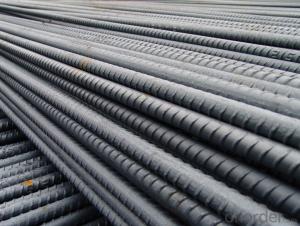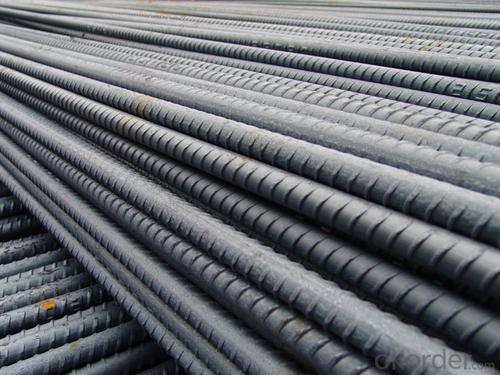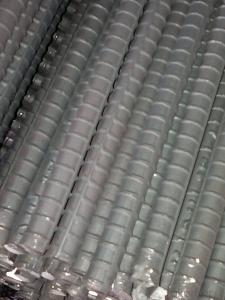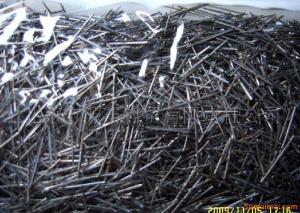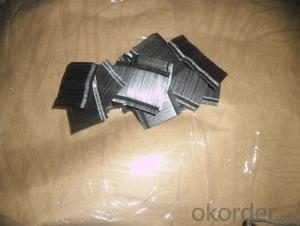Reinforcing Steel Rebar for Construction and Concrete
- Loading Port:
- China main port
- Payment Terms:
- TT or LC
- Min Order Qty:
- 100 m.t.
- Supply Capability:
- 100000 m.t./month
OKorder Service Pledge
OKorder Financial Service
You Might Also Like
Product Description:
OKorder is offering Reinforcing Steel Rebar for Construction and Concrete at great prices with worldwide shipping. Our supplier is a world-class manufacturer of steel, with our products utilized the world over. OKorder annually supplies products to African, South American and Asian markets. We provide quotations within 24 hours of receiving an inquiry and guarantee competitive prices.
Product Applications:
Reinforcing Steel Rebar for Construction and Concrete are ideal for structural applications and are widely used in the construction of buildings and bridges, and the manufacturing, petrochemical, and transportation industries.
Product Advantages:
OKorder's Reinforcing Steel Rebar for Construction and Concrete are durable, strong, and wide variety of sizes.
Main Product Features:
· Premium quality
· Prompt delivery & seaworthy packing (30 days after receiving deposit)
· Can be recycled and reused
· Mill test certification
· Professional Service
· Competitive pricing
Product Specifications:
Manufacture: Hot rolled
Grade: HRB335,HRB400,HRB500
Certificates: ISO, SGS, BV, CIQ
Length: 6m – 12m, as per customer request
Packaging: Export packing, nude packing, bundled
| DEFORMED BAR | |
| SIZE d(mm) | theoretical kg/m |
| 6 | 0.222 |
| 8 | 0.395 |
| 10 | 0.617 |
| 12 | 0.888 |
| 14 | 1.21 |
| 16 | 1.58 |
| 18 | 2 |
| 20 | 2.47 |
| 22 | 2.98 |
| 25 | 3.85 |
| 28 | 4.83 |
| 32 | 6.31 |
FAQ:
Q1: Why buy Materials & Equipment from OKorder.com?
A1: All products offered byOKorder.com are carefully selected from China's most reliable manufacturing enterprises. Through its ISO certifications, OKorder.com adheres to the highest standards and a commitment to supply chain safety and customer satisfaction.
Q2: what is the difference between actual weight and theoretical weight?
A2: All the section steel has two weights: actual weight and theoretical weight. Actual weight is the weighing out when the product delivered from the mill. Theoretical weight is calculated by pieces. The invoice can be based on each of them as your request.
Q3: How soon can we receive the product after purchase?
A3: Within three days of placing an order, we will arrange production. The normal sizes with the normal grade can be produced within one month. The specific shipping date is dependent upon international and government factors, the delivery to international main port about 45-60days.
Images:
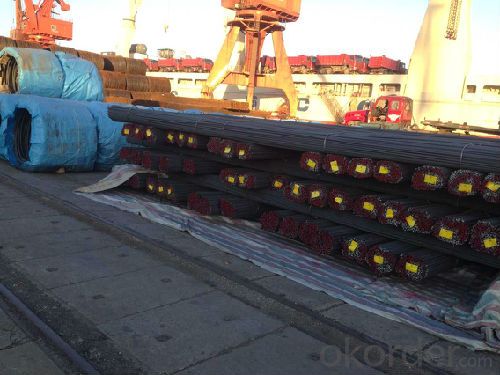
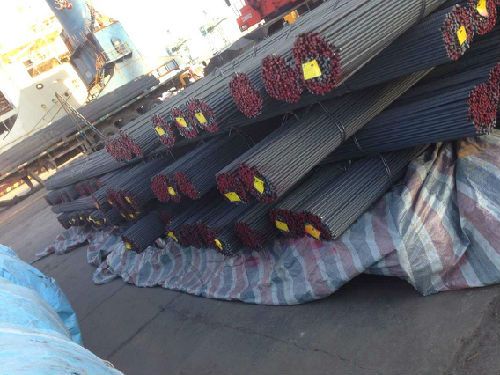
- Q: Can steel rebars be used in seawater desalination plants?
- Yes, steel rebars can be used in seawater desalination plants, but it is important to consider the corrosion potential of steel in a saline environment. Proper corrosion protection measures, such as using corrosion-resistant coatings or stainless steel rebars, should be implemented to ensure the longevity and structural integrity of the plant.
- Q: How do steel rebars contribute to the crack control in slabs and walls?
- The resistive properties of steel rebars contribute significantly to crack control in slabs and walls. When loads are applied to concrete slabs and walls, such as the weight of the structure or external forces, they can develop tensile stresses. However, concrete is strong in compression but weak in tension, which makes it susceptible to cracking under tensile forces. To counteract these tensile stresses, steel rebars are embedded within the concrete. The rebars absorb and distribute the tensile forces, preventing crack formation and controlling their propagation. Essentially, the rebars act as reinforcement, enhancing the overall tensile strength of the concrete. The presence of steel rebars in slabs and walls has the additional benefit of limiting the width and length of cracks that may occur. This is achieved by providing resistance against the tensile stresses. This crack control is of utmost importance in maintaining the structural integrity and durability of the concrete elements. Moreover, steel rebars also contribute to crack control by enhancing the overall ductility of the structure. Ductility refers to the ability of a material to deform under load without fracturing. By improving the ductility of the concrete, the rebars enable the structure to absorb energy and deform in a controlled manner. This reduces the likelihood of sudden failure or catastrophic collapse. In conclusion, steel rebars play a crucial role in crack control in slabs and walls. They increase the tensile strength of concrete, limit crack width and length, and improve overall structural ductility. Their presence ensures the long-term durability and safety of these concrete elements.
- Q: What are the typical costs associated with using steel rebars in a construction project?
- The typical costs associated with using steel rebars in a construction project can vary depending on factors such as the quantity and size of rebars required, market conditions, and location. However, in general, the costs can include the purchase price of the rebars themselves, transportation and delivery expenses, installation labor costs, and any additional fees or taxes. It is advisable to consult with suppliers and contractors to get accurate cost estimates for a specific construction project.
- Q: How do steel rebars contribute to the overall structural performance of a building?
- Steel rebars play a crucial role in enhancing the overall structural performance of a building. These reinforced steel bars are primarily used in concrete construction and provide strength and stability to the structure. Firstly, rebars reinforce the concrete by increasing its tensile strength. Concrete is highly resistant to compression forces, but it is weak when it comes to tension. By adding steel rebars, which have excellent tensile strength, to the concrete, the resulting composite material becomes much stronger and more resistant to bending or cracking under pressure. Moreover, rebars improve the durability and longevity of the building. Concrete structures are subjected to various forces such as wind, earthquakes, and heavy loads. Steel rebars act as a reinforcement network, distributing these forces throughout the concrete and preventing localized damage. This reinforcement helps to minimize the risk of structural failure, ensuring the building can withstand the test of time and environmental conditions. In addition, rebars contribute to the overall stability of the structure. By reinforcing concrete columns, beams, and slabs, rebars enhance their load-bearing capacity. This enables the building to support heavier loads without excessive deflection or collapse. The increased stability provided by the rebars also allows for more flexible and creative architectural designs, as they provide the necessary structural support for complex and unique building shapes. Furthermore, steel rebars are essential in seismic zones where earthquakes are common. The ductility and flexibility of steel allow it to absorb and dissipate the energy generated during an earthquake. This prevents the building from undergoing severe damage and helps it to retain its structural integrity, minimizing the risk to occupants. Overall, steel rebars significantly contribute to the overall structural performance of a building by enhancing its strength, durability, stability, and resistance to various forces. Their use ensures that the structure remains safe, long-lasting, and capable of withstanding the demands placed upon it, making them an indispensable component in modern construction.
- Q: What are the safety precautions to take when working with steel rebars?
- When working with steel rebars, it is important to follow several safety precautions. First, always wear appropriate personal protective equipment such as gloves, safety glasses, and steel-toed boots to protect yourself from potential injuries. Additionally, ensure that the work area is well-lit and free from any obstructions or tripping hazards. It is crucial to handle rebars with care to prevent cuts or punctures, so use proper lifting techniques and avoid dragging or sliding them. When cutting or bending rebars, use appropriate tools and always wear a face shield to protect against flying debris. Finally, be aware of the potential for falling rebars and use proper storage methods to prevent accidents.
- Q: What is the effect of steel rebars on the durability of concrete structures?
- The durability of concrete structures is greatly influenced by the presence of steel rebars. When used as reinforcement within the concrete, rebars bolster the strength and longevity of the structure. While concrete itself is strong when compressed, it lacks tensile strength. However, by incorporating steel rebars, which possess high tensile strength, into the concrete, the overall structural integrity is significantly improved. The inclusion of rebars in concrete serves to mitigate the potential for cracking and structural failure. When exposed to external forces or natural phenomena such as earthquakes or temperature fluctuations, the rebars distribute the load and aid in resisting bending, shearing, and tension forces. This effectively prevents the occurrence of cracks and ensures the concrete structure remains whole and stable. Furthermore, steel rebars also provide protection against corrosion for the concrete. Concrete is susceptible to moisture and chemicals that can penetrate its surface and lead to the corrosion of embedded reinforcement. However, rebars act as a barrier, safeguarding the concrete from moisture and harmful substances that could cause corrosion. This extends the lifespan of the structure and reduces the need for maintenance and repairs. In conclusion, the addition of steel rebars in concrete structures greatly enhances their durability. They offer increased strength, resistance to external forces, and protection against corrosion. When combined, concrete and steel rebars create a robust and long-lasting structure capable of withstanding various environmental and structural challenges.
- Q: What are the different uses of wire rod and thread steel?
- According to statistics, China's construction industry accounts for about 50% of the total steel consumption. As one of the resources consuming industries, the construction industry must adjust the consumption structure of construction materials, energetically apply high-strength steel bars and high-performance coagulation, and take the road of economical development. If the current use of steel and concrete to raise an intensity level, it can bring enormous savings to society. For example, by calculation, according to the standard requirements, if the reinforced concrete leading force steel strength increased to 400-500N/mm2, then can be in the current level of steel consumption to save about 10%.
- Q: What is the minimum yield strength of steel rebars?
- The minimum yield strength of steel rebars is typically around 40,000 pounds per square inch (psi).
- Q: How are steel rebars used in the construction of dams?
- The construction of dams relies heavily on steel rebars, as they offer the necessary strength and stability to the structure. Dams, which are massive concrete constructions designed to contain water for various purposes like hydroelectric power generation, irrigation, and flood control, greatly benefit from the presence of steel rebars. Steel rebars, also referred to as reinforcing bars, are essential in reinforcing the concrete and enhancing its ability to withstand tension. Although concrete is excellent at withstanding compression, it is relatively weak when it comes to tension. This is where steel rebars come into play, as they are strategically positioned inside the concrete structure to counteract any tensile forces that may lead to cracks or failure. Typically, in the construction of dams, steel rebars are embedded within the concrete in a crisscross manner, forming a network of reinforcement. This configuration helps to evenly distribute the load and resist the immense pressure exerted by the water behind the dam. By reinforcing the concrete, steel rebars ensure that the dam can withstand various forces, including the weight of the water, water pressure, and external factors such as earthquakes. Moreover, steel rebars also serve to prevent cracks from spreading within the concrete. In the event of minor cracks caused by environmental factors or settlement, the rebars act as a barrier, preventing the cracks from expanding and compromising the structural integrity of the dam. To ensure their strength and durability, steel rebars used in dam construction must meet specific standards and specifications. Typically, they are made from high-strength steel capable of withstanding the immense pressures and forces encountered during dam construction. In conclusion, the presence of steel rebars is vital in the construction of dams as they reinforce the concrete, provide the necessary strength and stability, and prevent the propagation of cracks. Their strategic placement and configuration aid in load distribution, tension resistance, and the maintenance of the dam's structural integrity and reliability.
- Q: What is the impact of steel rebars on the carbon footprint of a structure?
- The carbon footprint of a structure is greatly affected by the utilization of steel rebars in construction. Steel production is widely recognized as a carbon-intensive process, leading to the emission of greenhouse gases and contributing to climate change. The extraction and processing of iron ore, in addition to the energy-intensive procedures involved in transforming it into steel, generate substantial amounts of carbon dioxide (CO2). Commonly employed to reinforce concrete structures like buildings, bridges, and highways, steel rebars play a significant role in the carbon emissions associated with a structure. The manufacture of cement, a crucial constituent of concrete, also serves as a major source of carbon emissions. Consequently, both steel production and concrete manufacturing processes influence the carbon footprint of a structure. Nevertheless, it is important to acknowledge the potential positive impact of steel rebars on a structure's carbon footprint. Steel possesses exceptional durability and can outlast the structure itself. This longevity diminishes the necessity for frequent maintenance, repairs, and replacements, which would otherwise consume additional resources and emit more carbon. Furthermore, steel rebars enhance the structural strength and resilience of a building, enabling it to withstand extreme weather events and seismic activities. This heightened durability prolongs the lifespan of the structure, reducing the requirement for new construction and the associated carbon emissions in the long term. Efforts are being made to mitigate the carbon footprint of steel rebars by enhancing the efficiency of steel production processes. This includes the adoption of cleaner technologies and the utilization of recycled steel. Additionally, there is a growing inclination towards incorporating sustainable materials such as bamboo or fiber-reinforced polymers as alternatives to steel rebars in construction. To conclude, although the production of steel rebars generates a substantial carbon footprint, their use in construction can contribute to the overall sustainability of a structure by providing durability and diminishing the need for frequent replacements. However, it is crucial to consistently explore and implement more sustainable alternatives to steel rebars in order to further minimize the carbon impact of construction.
Send your message to us
Reinforcing Steel Rebar for Construction and Concrete
- Loading Port:
- China main port
- Payment Terms:
- TT or LC
- Min Order Qty:
- 100 m.t.
- Supply Capability:
- 100000 m.t./month
OKorder Service Pledge
OKorder Financial Service
Similar products
Hot products
Hot Searches
Related keywords
